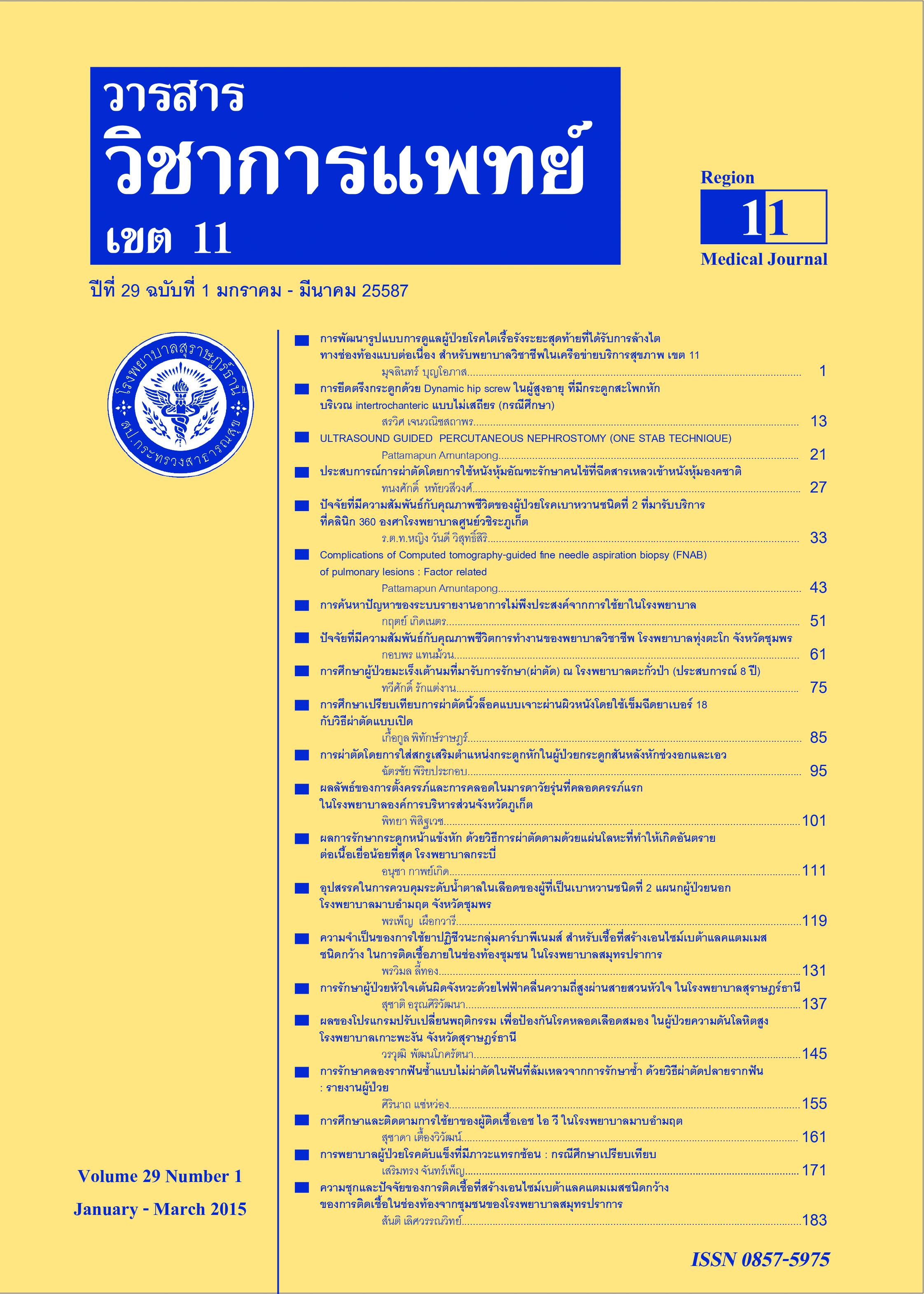การยึดตรึงกระดูกด้วย Dynamic hip screw ในผู้สูงอายุ ที่มีกระดูกสะโพกหักบริเวณ intertrochanteric แบบไม่เสถียร (กรณีศึกษา)
บทคัดย่อ
การผ่าตัดรักษาผู้ป่วยสูงอายุที่มีกระดูกสะโพกหักบริเวณ intertrochanter (IT) ที่ไม่เสถียร ด้วย Dynamic hip screw (DHS) มีโอกาสเกิดการยึดตรึงกระดูกล้มเหลวได้บ่อย จากภาวะกระดูกพรุนและการยึดตรึงกระดูกไม่มั่นคง
วัตถุประสงค์ เพื่อศึกษาผลการรักษาทางคลินิกและปัจจัยทางเทคนิคของการผ่าตัดรักษาและปัจจัยที่มีผลต่อการรักษาผู้ป่วยกระดูกสะโพกหักบริเวณ IT ที่ไม่เสถียร Evans’ classification type I ด้วย DHS ในสูงอายุ
วิธีการศึกษาเชิงวิเคราะห์ย้อนหลังผู้ป่วย 4 ราย ที่มี กระดูกสะโพกหักบริเวณ IT ที่ไม่เสถียร Evans’classification type I ที่เกิดจากอุบัติเหตุที่ไม่รุนแรง อายุมากกว่า 55 ปี และได้รับการผ่าตัดยึดตรึงกระดูกด้วยDHS ผลการผ่าตัดดูจากอาการทางคลินิกและภาพถ่ายเอ็กซเรย์กระดูกสะโพกหลังผ่าตัดและเมื่อกระดูกติดดีแล้ว โดยการวัด Neck shaft angle, Tip-apex distance (TAD) ความแตกต่างความยาวของขาทั้งสองข้าง การดึงจัดเข้าที่ของ femoral calcar และระยะเวลาการติดของกระดูกที่หัก
ผลการรักษา ผู้ป่วย 4 ราย ชาย 2 ราย หญิง 2 ราย อายุเฉลี่ย 75.5 ปี หลังกระดูกที่หักติดแล้ว พบค่าเฉลี่ยของ Neck shaft angleเท่ากับ 140 ํ, TADเท่ากับ 18 มม. ผู้ป่วย 3 รายสามารถดึงจัดกระดูกที่หักบริเวณ femoral calcarเข้าที่ได้ anatomical reduction อีก 1 รายไม่เข้าที่ ความแตกต่างความยาวของขาทั้งสองข้าง 1 ราย ยาวกว่าเดิม 1 ซม. เท่ากัน 1 ราย และสั้นกว่าเดิม 2 ราย กระดูกติดดีทั้ง 4 ราย ระยะเวลาการติดของกระดูกที่หักเฉลี่ย 3.4 เดือน
สรุป ปัจจัยที่ทำ ให้ประสบความสำเร็จในการผ่าตัดยึดตรึงกระดูกผู้ป่วยสูงอายุที่มีสะโพกหักบริเวณ intertrochanter ที่ไม่เสถียร ได้แก่ การดึงจัดกระดูกเข้าที่บริเวณ femoral calar , Neck shaft angle ≥ 135 ํ การจัดวางตำ แหน่งของ hip screw ให้ TAD ≤ 25 มม. และเดินไม่ลงน้ำหนักหลังการผ่าตัด ประมาณ 6 สัปดาห์ เมื่อมี callus แล้วจึงเดินลงน้ำหนักบางส่วน
เอกสารอ้างอิง
2. Davis TRC, Sher JL, Horsman A, Simpson M, Porter BB, Cheketts RG. Intertrochanteric femoral fractures Mechanical failure after internal fixation. JBJS [Br] 1990;72:26–31.
3. Kim WY, Han CH, Park JI, Kim JY Failure of intertrochanteric fracture fixation with a dynamic hip screw in relation to pre-operative fracture stability and osteoporosis. Int Orthop 2001;25(6):360-2.
4. Weinlein JC. Intertrochanteric femoral fractures’ treatment. In: Canale ST, Beaty JH, editors. Campbell’s operative orthopaedics.12th ed. Philadelphia: Elsevier Mosby; 2013. p. 2738-49.
5. Kumar R,Singh R.N., Singh B.N. Comparative prospective study of proximal femoral nail and dynamic hip screw in treatment of intertrochanteric fracture femur .J Clin Orthop Trauma 2012;3(1):28-36.
6. Flores LA, Harrington IJ, Martin H. The stability of intertrochanteric fractures treated with a sliding screw plate. J Bone Joint Surg [Br] 1990; 72:37–40.
7. Setiobudi T1, Ng YH, Lim CT, Liang S, Lee K, Das De S. Clinical outcome following treatment of stable and unstable intertrochanteric fractures with
dynamic hip screw. Ann Acad Med Singapore. 2011 ; 40(11):482-7.
8. Dimon JH, Hughston JC. Unstable intertrochanteric fractures of the hip. J Bone Joint Surg Am.1967 ; 49(3):440-50.
9. Pajarinen J1, Lindahl J, Savolainen V, Michelsson O, Hirvensalo E. Femoral shaft medialisation and neck-shaft angle in unstable pertrochanteric
femoral fractures. Int Orthop. 2004 ; 28(6):347-53.
10. Haidukewych GJ. Intertrochanteric fractures:Ten Tip to Improve Results.J Bone Joint Surg Am. 2009; 91:712-9.
11. Baumgaertner MR, Curtin SL, Lindskog DM, Keggi JM. The value of the tip-apex distance in predicting failure of fixation of peritrochanteric fractures of the hip. J Bone Joint Surg Am 1995 ; 77(7):1058-64.
12. Guven M, Yavuz U, Kadioglu B, Akman B, Kilincoglu V, Unay K, et al. Importance of screw position in intertrochanteric femoral fractures treated by
dynamic hip screw. Orthop Traumatol Surg Res 2010 ;96(1):21-7.
13. Abdulkareem IH. A review of tip apex distance in dynamic hip screw fixation of osteoporotic hip fracture. Niger Med J 2012; 53(4) :184-191.
14. Hsueh KK, Fang CK, Chen CM, Su YP, Wu HF, Chiu FY. Risk factors in cutout of sliding hip screw in intertrochanteric fractures: an evaluation of 937
patients. Int Orthop 2010; 34(8):1273-6.
15. De Bruijn K, den Hartog D, Tuinebreijer W, Roukema G. Reliability of predictors for screw cutout in intertrochanteric hip fractures J Bone Joint Surg
Am 2012 ;94(14):1266-72.
16. Gundle R, Gargan MF, Simpson AHRW. How to minimize failure of fixation of unstable intertrochanteric fractures.Injury 1995; 26(9):611-4.
17. Lichtblau S. The unstable intertrochanteric hip fractures. Orthopedics 2008; 31(8):792-7.
18. Mak JCS, Ian D Cameron and Lyn M March. Evidence- based guidelines for the management of hip fractures in older persons: an update. Med J Aust 2010; 192 (1): 37-41.
19. Lindskog DM,Baumgaertner MR. Unstable intertrochanteric hip fractures in the elderly. J Am Acad Orthop Surg 2004;12(3):179-90.
20. Audige L, Hanson B, Swiontkowski MF. Implantrelated complications in the treatment of unstable intertrochanteric fractures: meta-analysis of dynamic screw-plate versus dynamic screw-intramedullary nail devices. Int Orthop 003;27(4):197-203.






